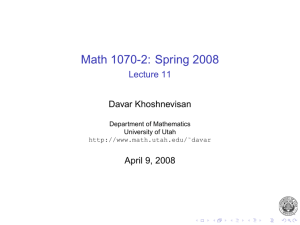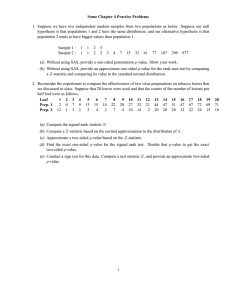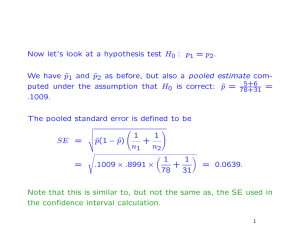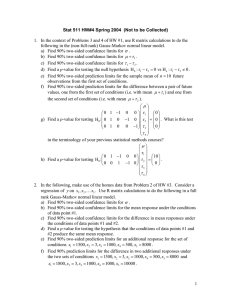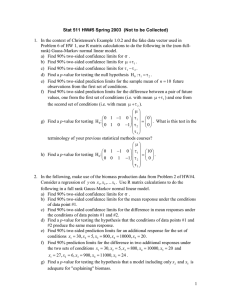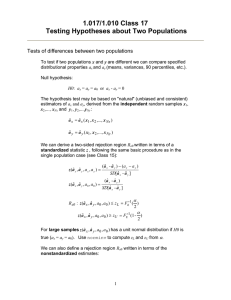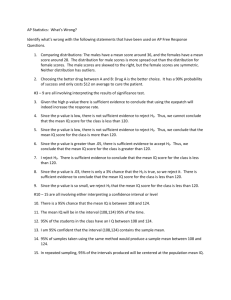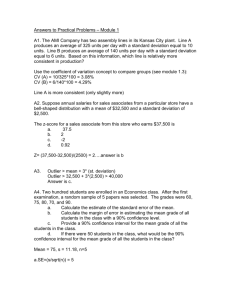11solutions8
advertisement
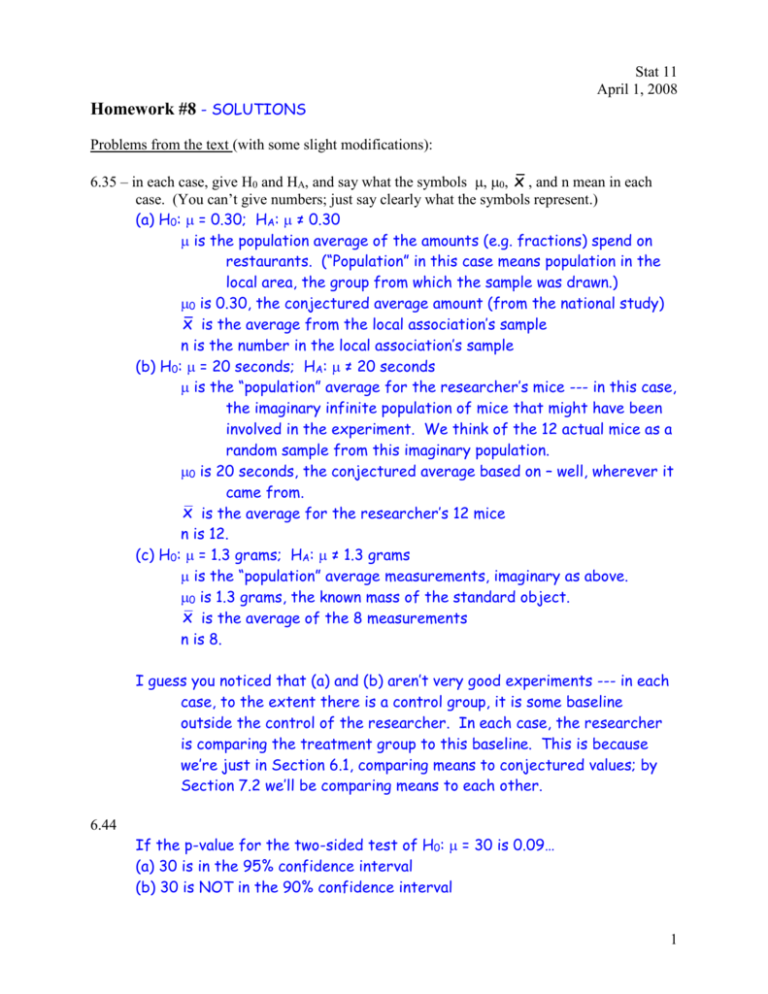
Stat 11 April 1, 2008 Homework #8 - SOLUTIONS Problems from the text (with some slight modifications): 6.35 – in each case, give H0 and HA, and say what the symbols , 0, x , and n mean in each case. (You can’t give numbers; just say clearly what the symbols represent.) (a) H0: = 0.30; HA: ≠ 0.30 is the population average of the amounts (e.g. fractions) spend on restaurants. (“Population” in this case means population in the local area, the group from which the sample was drawn.) 0 is 0.30, the conjectured average amount (from the national study) x is the average from the local association’s sample n is the number in the local association’s sample (b) H0: = 20 seconds; HA: ≠ 20 seconds is the “population” average for the researcher’s mice --- in this case, the imaginary infinite population of mice that might have been involved in the experiment. We think of the 12 actual mice as a random sample from this imaginary population. 0 is 20 seconds, the conjectured average based on – well, wherever it came from. x is the average for the researcher’s 12 mice n is 12. (c) H0: = 1.3 grams; HA: ≠ 1.3 grams is the “population” average measurements, imaginary as above. 0 is 1.3 grams, the known mass of the standard object. x is the average of the 8 measurements n is 8. I guess you noticed that (a) and (b) aren’t very good experiments --- in each case, to the extent there is a control group, it is some baseline outside the control of the researcher. In each case, the researcher is comparing the treatment group to this baseline. This is because we’re just in Section 6.1, comparing means to conjectured values; by Section 7.2 we’ll be comparing means to each other. 6.44 If the p-value for the two-sided test of H0: = 30 is 0.09… (a) 30 is in the 95% confidence interval (b) 30 is NOT in the 90% confidence interval 1 6.45 If the p-value for the two-sided test of H0: = 30 is 0.04… (a) 30 is NOT in the 95% confidence interval (b) 30 is NOT in the 90% confidence interval 6.54 – Would your result change if the test were two-sided? Does it matter that the data probably aren’t normal? H0: = 8.9 (new words per sonnet) HA: > 8.9 In this case n = 6 and x = 10.2, and we’re given = 2.5. The test statistic is z x 0 n 10.2 8.9 1.273735 2.5 6 and the one-sided p-value is 0.101. (That’s from Excel; =1-NORMSDIST(1.273735).) +1.27 probability .101 Conclusion: The result is NOT statistically significant, and we can’t rule out the possibility that these poems are by the claimed author. If this were a two-sided test (and it definitely should be; there’s no a priori reason to think would be greater than 8.9) then the p-value would be twice as much --- it would include both tails. That is, the p-value would be 0.202, even less impressive. The conclusion would be the same. 6.55(a) – Think about part (b), too, but don’t turn it in. H0: = 115; HA: > 115. n = 25; x = 132.2; we’re given = 30. Test statistic: z x 0 n 132.2 115 2.867 30 25 The p-value is about 0.0021. Conclusion: This IS statistically significant. We can reject the null hypothesis. The experiment is evidence that older student do average higher scores on the test. 2 6.68 Given H0: = 0 and HA: > 0… (a) We would reject H0 if z > +1.645. (NOT 1.96; that would be for a two-sided test. 1.645 is the z* that leaves 5% in the upper tail.) (b) Now HA is 0, and the answer is that we reject H0 if z > +1.9600 OR if z < -1.9600. (c) In (b) we’re dividing the 5% rejection region between two 2.5% tails. 6.82 – If you would prefer to do a two-sided test, then do that. (a) n=100, x =483, =100. The test statistic is z x 0 n 483 480 0.30 100 100 which is NOT significant. (b) Now n = 1000 and z = 0.949, still not significant (c) Finally, n = 10000 and z = 3.00, significant even at the 1% level. The point of the problem is that a 3-point improvement probably isn’t IMPORTANT, even if we’re sure it’s real. (Statistically significant = we’re sure it’s real.) 7.11 – The numbers in the problem are x and s. Test H0: = 0. (a) t x 0 n 328 0 5.125 256 16 Compare to t*0.025, 15 = 2.131 (for a 95% test) and reject H0. (b) The 95% confidence interval is [ 328 – 2.131 times 64, 328 + 2.131 times 64 ] = about [ 192, 464 ]. This is more informative than the test, because it gives you a range for the actual value of the average improvement. (The test just tells you that the value isn’t 0.) 7.37(b) n = 12, x = 104.13, s = 9.40, SE = 9.40/sqrt(12) = 2.71. The average measurement is barely a third of an SE away from the true value. No, there is NOT convincing evidence that the mean reading of all detectors would be different from 105. (end) 3
